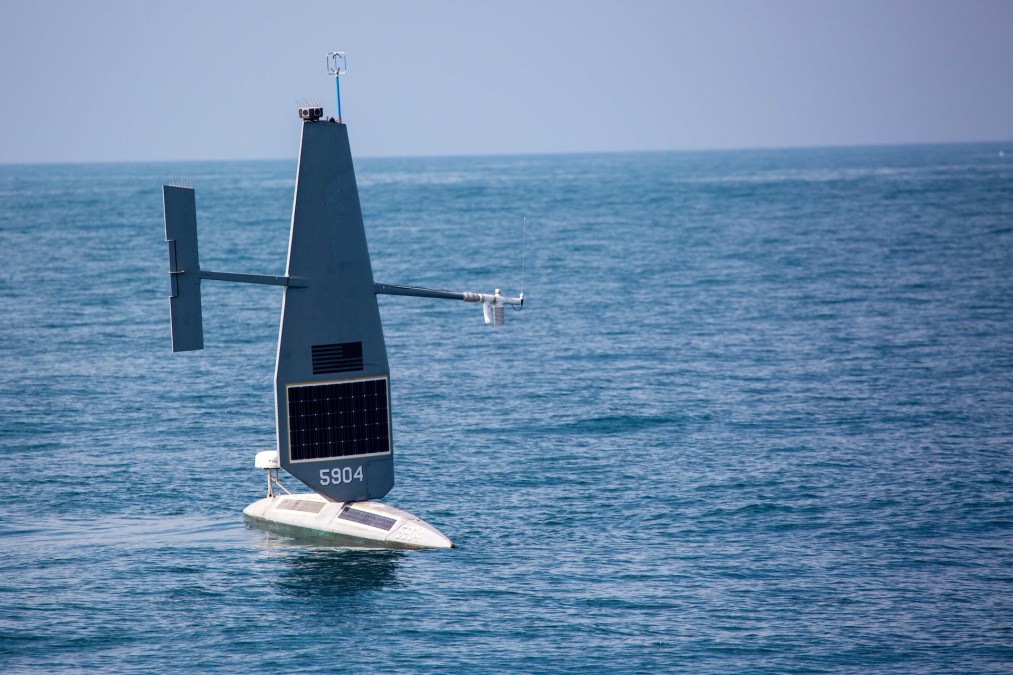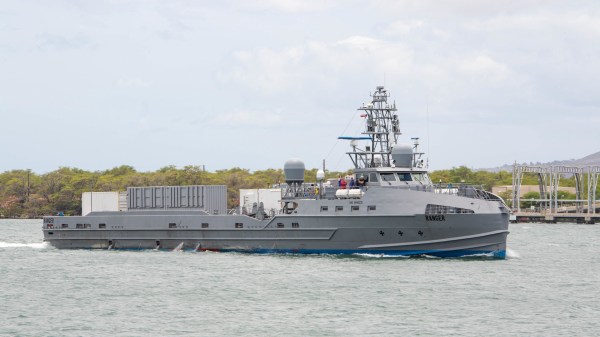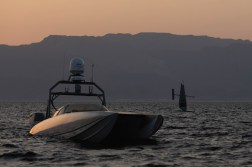Deploying contractor-owned robotic vessels could be a fruitful long-term option for the Navy, Secretary Del Toro says

Leveraging contractor-owned maritime drones to augment the Navy’s fleet could be a good long-term option for deploying robotic platforms, Navy Secretary Carlos Del Toro told DefenseScoop.
The Navy’s 5th Fleet has been experimenting with this concept for Task Force 59, which is using unmanned surface vessels equipped with cameras to perform intelligence, surveillance and reconnaissance missions in the waters near the Middle East. The commander of 5th Fleet, Vice Adm. Brad Cooper, has referred to this deployment model as CONOCO — contractor-owned, contractor-operated, with Navy oversight. That will be the near-term model for Task Force 59, he told DefenseScoop and other reporters in October.
During an interview with DefenseScoop on the sidelines of ASNE’s Combat Systems Symposium on Wednesday, Del Toro said contractor-owned drones could help the sea service overcome acquisition challenges and keep pace with technological change.
“As we try to tackle the challenge of getting over this valley of death [in the acquisition system], and as we look at the rapidly changing pace of technology as it evolves, I think that that’s a model that has to be taken under consideration without question,” he said. The term “valley of death” in Pentagon parlance refers to failures in moving U.S. military capabilities into production and fielding.
“That’s not to suggest that it will all be contractor-owned, but where it does make sense where it can actually result in a more efficient, effective model for deployment, I think it does make sense to do that. And so I’m open to that consideration,” he added.
Del Toro and other Navy leaders are gung-ho about creating new “mesh networks” of unmanned systems enabled by artificial intelligence, the cloud and other supporting technologies.
“I think part of the key to success [in leveraging robotic platforms] is building — is the mesh network itself, right. So having it built in an open architecture sort of way where people can feed into that mesh, regardless of what specific technology they use on their unmanned platform. But they can actually feed into it so that can be fully collaborative and integrated with, you know, our Navy, our manned ships and other unmanned technology as well,” he said.
In the early stages of moving toward a “hybrid fleet” of manned and uncrewed platforms, robotic vessels are expected to be used for ISR-type missions and for cuing manned platforms. Eventually, the sea service envisions deploying large unmanned surface vessels that carry missiles or other weapons.
The contractor-owned model would be more suited toward ISR or other non-lethal activities, Del Toro suggested.
“When it comes to unmanned platforms that actually have weapons on them, the U.S. government will own those and control those unquestionably. So let me make that perfectly clear absolutely. But in the ones that don’t have weapons systems on them, that are just unmanned platforms, then there’s no reason why contractors can’t actually own this — sort of like a software-as-a-service model,” he told DefenseScoop.
During his remarks to attendees at the ASNE conference, Del Toro noted that the U.S. Saildrone systems that Iran temporarily captured last year were contractor owned.
“If you look at Saildrone, for example, we don’t own the actual platforms. All the data is in the cloud. But we actually don’t own the platform or the camera that goes on the Saildrone. So if it’s actually captured by an adversary, like the Iranians tried to do … there’s no data loss, right. So, it’s going to require a whole new way of thinking about how to use this technology to our advantage,” he said.
Del Toro sees a “really bright” future for uncrewed systems.
However, “it does come with challenges that have to be paid attention to before we actually go to sort of full production of those particular individual unmanned technologies … But it also demands a whole different way of thinking, right. Because it’s about taking a piece of gear that the government may or may not own,” he said, noting the operational experimentation with Saildrone tech.
Developing concepts of operation for drones and training personnel to leverage the technology will also be critical aspects of moving toward a hybrid fleet, he noted.
Senior officials have been highlighting industrial base issues that hinder the expansion of the Navy’s fleet of manned platforms, including shipbuilding delays, shipyard capacity shortfalls and workforce challenges. DefenseScoop asked Del Toro if he expects the Navy will run into similar problems as uncrewed systems move into production.
“Some of those issues will be there as well, too. But I think what’s exciting too is that a lot of these platforms are smaller — so I hope it actually increases the ability to bring in smaller shipyards that will be able to also compete for some of these contracts and increase our supply chain in a much greater way. Because we need more competition in the shipbuilding industry. There’s no question about that. We need smaller shipyards to, you know, to rise and start building some of these capabilities that we’re going to need in the future,” he said.






